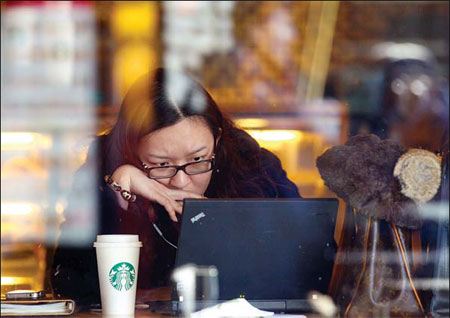No coffee mourning over expensive drinks in Starbucks
Updated: 2012-02-09 08:09
By Gao Changxin and Wang Jingshu (China Daily)
|
||||||||
|
A customer is absorbed in thought at Starbucks in Sanlitun, Beijing, on Tuesday. [Zou Hong / China Daily] |
Prices on par with US fail to deter Chinese customers who want a taste of 'the good life', report Gao Changxin in Shanghai and Wang Jingshu in New York.
Su Nan stood inside a Starbucks on Shanghai's bustling Huaihai Road and complained about the US coffee chain's recent price hike. "It's already expensive. How am I going to live?"
But the 26-year-old still joined a long line for a latte.
The world's biggest coffee chain raised the price of some products on Jan 31, due to what it said were rising operating costs. That brought Su's 16-ounce (about half a liter) "grande" cup to 30 yuan ($4.75) from 28 yuan.
Starbucks was already an expensive choice for regular Chinese customers such as Su, who earns about 7,000 yuan a month. One cup of cappuccino a day for a year would cost her 10,950 yuan - about one-eighth of her income.
Still, Su is better off than many others. China's per capita GDP last year was $5,184. It was $48,147 in the US.
Despite a huge gap in personal income, Starbucks has priced its products almost the same in China as in the US, if not higher, since it entered the Chinese market in 1999.
It also raised prices recently in the US Northeast and Sunbelt, by an average of about 1 percent. In New York, a 12-ounce latte now sells for $2.85 and plain brewed coffee was $1.65. The price of a 16-ounce, "grande" cup of coffee is unchanged at $2.20 plus 20 cents in local tax.
But Chinese consumers, who traditionally drink tea and have little taste for coffee, seem not to mind paying a relatively higher price. They have become one of the engines of growth for Starbucks.
The company has become so popular in China that it opened its 500th store in October, in Beijing, and plans to triple the number by 2015. Globally, Starbucks had 17,003 stores in 58 countries as of Oct 2.
In China, it's expanding not just in the big and rich areas but also in so-called second-tier cities, where consumers have much less disposable income. In December, Starbucks announced it had entered five more Chinese cities, including Langfang in Hebei province, which can hardly be rated as second-tier. Annual per-capita GDP is just above $3,000.
Positioning move
Operating costs in China are much lower than in the US. So why do Starbucks and other American companies price their food and beverages higher in China? Two professors from Long Island University in New York offer explanations.
"From the marketing perspective, the price-setting reflects how the brand positions itself in the market," said T. Steven Chang, chair and professor of marketing and international business. "Therefore, cost is not the only factor considered by the company.
"Starbucks actually is selling their whole package, including the symbol of good taste and prestige, the Westernized atmosphere they created in each retail store, and high-quality coffee and food."
Thomas C. Webster, a professor of public administration and public economics, said, "Usually prices are set based on the conditions of the specific market. In the case of China, the market is probably not saturated with competitors, so if people want designer coffee - which many regard as a status symbol - they are willing to pay the higher price.
"If Starbucks starts making large profits," Webster said, "then you will see other competitors enter the market and that will drive the price down."

 Relief reaches isolated village
Relief reaches isolated village
 Rainfall poses new threats to quake-hit region
Rainfall poses new threats to quake-hit region
 Funerals begin for Boston bombing victims
Funerals begin for Boston bombing victims
 Quake takeaway from China's Air Force
Quake takeaway from China's Air Force
 Obama celebrates young inventors at science fair
Obama celebrates young inventors at science fair
 Earth Day marked around the world
Earth Day marked around the world
 Volunteer team helping students find sense of normalcy
Volunteer team helping students find sense of normalcy
 Ethnic groups quick to join rescue efforts
Ethnic groups quick to join rescue efforts
Most Viewed
Editor's Picks

|

|

|

|

|

|
Today's Top News
Health new priority for quake zone
Xi meets US top military officer
Japan's boats driven out of Diaoyu
China mulls online shopping legislation
Bird flu death toll rises to 22
Putin appoints new ambassador to China
Japanese ships blocked from Diaoyu Islands
Inspired by Guan, more Chinese pick up golf
US Weekly

|

|








